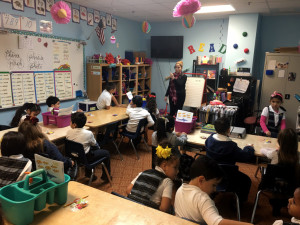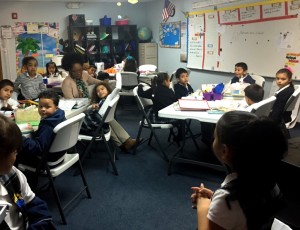by Nia Nuñez-Brady
ORLANDO, Fla. – At first glance, the IEC Christian Academy might look like a typical school, but a closer look reveals some distinctive features that match its surrounding community in South Orlando.

Hispanic food twice a week. English classes for parents. A lawyer who gives free legal advice. The school even has a special fund, called Seeds of Love, which helps parents with various emergencies, like paying their electric bills and filling their gas tanks in times of need.
“At IEC, we are a family, and when a family member struggles, we help,” said Lissette Vazquez, the school’s marketing director.
Parents and teachers at the school, which is affiliated with the church Iglesia el Calvario, say it goes above and beyond to serve a predominantly Hispanic population.
As parents drop off their children in the morning on campus, they are greeted by five staff members who help students get their things into the chapel for morning prayer.
“They help the neediest people. Including my family,” said Maria Rivas, a mother of one who moved from El Salvador nine years ago. “They teach my daughter English, while they explain everything to me in Spanish. That is a blessing,” she added.
In an interview conducted in Spanish, Rivas, who works 32 hours a week as a maid, said she struggles to give her child the necessary $15 a week for lunch, but the school never lets her daughter go hungry.
“We have families who have had no electricity and we have paid for them, we have funds designated as ‘Seeds of Love’ for these instances.”
The school teaches parents as well as children. It offers English classes after school, which allow parents and students help one another do homework. At the end of the semester, the parents finish by speaking to the entire class in English.

The 11-year-old school currently serves students from preschool to tenth grade, but it is still growing. Next year it hopes to add eleventh grade and start building a sports facility that will include basketball, soccer, and volley ball.
Of its 239 students, 199 receive tax credit scholarships for low-income students, and 95 percent are Hispanic. Step Up For Students, which publishes this blog, helps administer the scholarship program.
IEC Academy is growing at a time when schools in Florida and throughout the country are grappling with a mismatch between students and faculty. Hispanics now make up nearly a third of all public-school students in the state, and their numbers are projected to continue growing. But the teaching force and administrative ranks have not kept up.
In the 2015-16 school year, 31.5 percent of public-school students are Hispanic, compared to 12.5 percent of principals and 14 percent of teachers, according to survey data kept by the state Department of Education.
Orange County Public Schools, where IEC is located, has more diverse teachers and administrators than the state as a whole, but the disparity remains. The student population is 38 percent Hispanic, compared to 17 percent of principals and 16 percent of teachers.
Denise Vega, the principal at IEC, said many parents are drawn to the school because they feel the faculty speak their language and understand their culture.
“Just because we are Hispanic, does not mean we are not diverse,” she said. “Our families come from Puerto Rico, Mexico, Cuba, Peru, Colombia and all over Latin America and we all have different customs.” The school employs many Latin-American teachers who are able to communicate with Spanish-speaking parents.
Every year, the school puts together a Hispanic Heritage month talent show to showcase Latin America. Each grade picks a country and brings food and clothing representing that particular region.
Parents at the school also help each other. Vega said Rosa Cruzado, an immigrant from Peru, helps parents apply for scholarships, and gives them an overview of the American school system.
It is no secret that the Hispanic community faces unique educational issues in Florida.
The most recent available test data in Florida showed that only 50 percent of Hispanic 10th graders passed the reading test they need to graduate. Nationally, only 16 percent of Hispanic students in the fourth grade are proficient in reading, compared to 41 percent of White students.
“When the students start at our school, they are usually one and half years behind in their curriculum,” said Vega, who is also the children’s pastor at the church. To help them catch up, the school offers one-one-one ‘help time’ for students who are behind in their studies. The Orange County school district provides two full-time teachers funded through Title I, the federal program for high-poverty schools, to help at-risk children.
In addition to the academic support, parents at the school say they want to have their children in an environment that reinforces the beliefs in their homes.
“Values and morals start at home, but a bad environment could ruin a child’s life,” said Claritza Amador, mother of fifth-grader Japhed Amador. She explained that her neighborhood school is graded “F” and when she drives by the school in the morning, she sees children fighting and the girls wearing provocative clothes.
“All my neighbors ask me, ‘how are you able to afford a private school?” she added. “And I always tell them that having a scholarship has changed our lives.”



Very Informative… Thanks